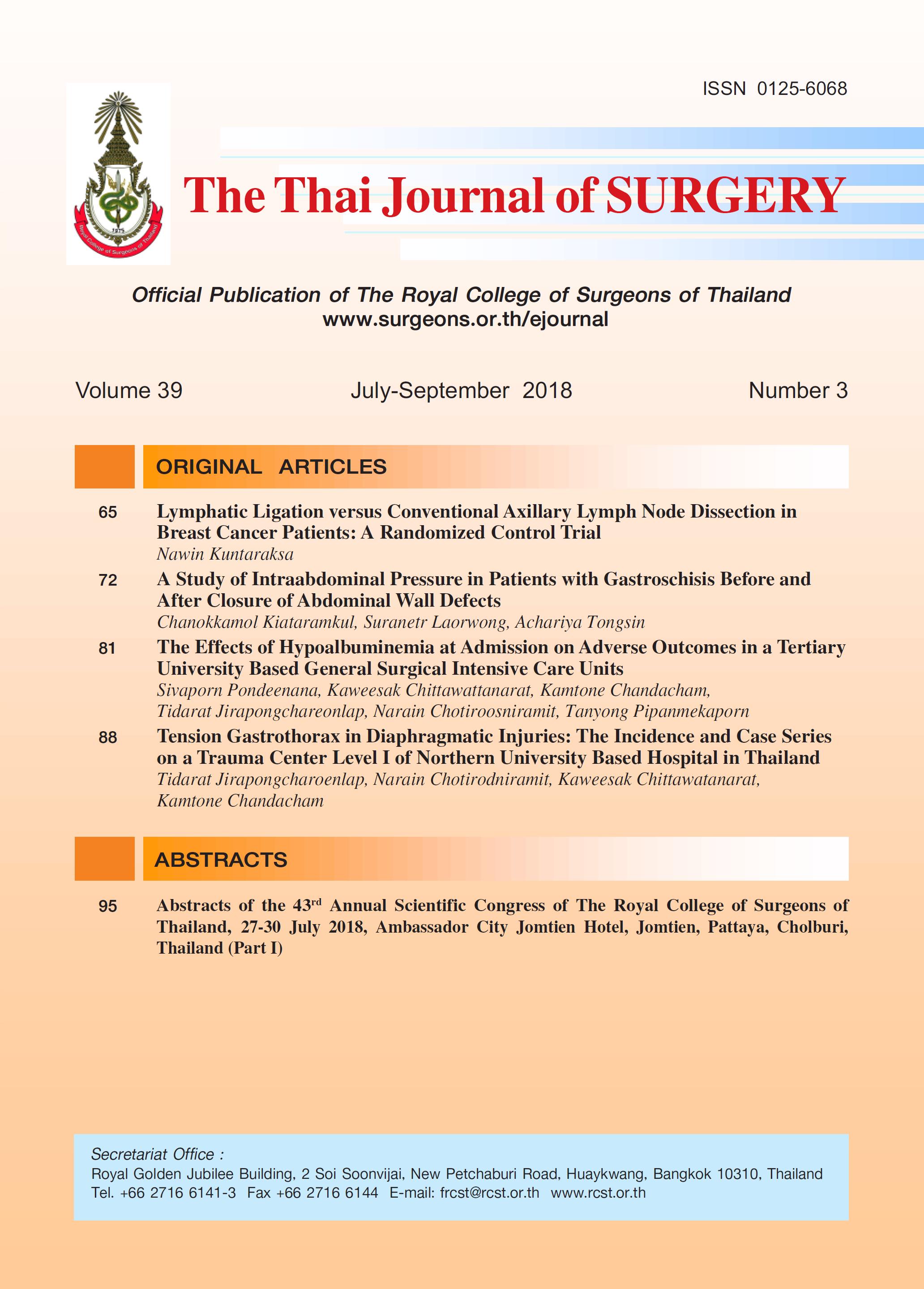The Effects of Hypoalbuminemia at Admission on Adverse Outcomes in a Tertiary University Based General Surgical Intensive Care Units
Keywords:
Hypoalbuminemia, surgical intensive care unit, mortality, infection, acute kidney injuryAbstract
Background: Although albumin is the marker of nutrition status but the albumin level usually low on acute illness and its level on outcome is controversy. The objective of this study was to determine the effect of serum albumin which on morbidity and mortality in hospitalized surgical patients admitted to general surgical intensive care unit (SICU).
Method: We performed an ambispective cohort study between 2011-2013. All patients who admitted to SICU were enrolled to this observation. The albumin level, severity of disease, type of surgery and demographic data were collected on the SICU admission. The outcomes included the length of mechanical ventilator day, hospital and SICU stay, lung complication, septicemia, urine infection, acute kidney injury, surgical site infection, new-onset upper gastrointestinal hemorrhage, delirium, seizure, myocardial infarction and mortality were recorded at patient discharge. We categorized the patient into two group based on admission albumin level as normal group (≥ 3.5 g/dL) and hypoalbuminemia group (< 3.5 g/dL)
Results: A total of 893 patients were enrolled and analyzed in this study. Of these, the normal and hypoalbuminemia group were 106 (11.9%) and 787 (88.1%) respectively. After adjusted the adverse outcomes by multivariable analysis, the hypoalbuminemia group had significant higher risk of infective complication [Odds ratio (95% confidence interval): 2.68 (1.35 - 5.30); p = 0.005] especially on pulmonary infection [2.08 (1.01 - 4.27); p = 0.046], acute kidney injury [4.06 (1.44 - 11.47), p = 0.008], and mortality [5.92 (2.12 - 16.54); p = 0.001]
Conclusion: The incidence of hypoalbuminemia is common in SICU. The hypoalbuminemia patients increase risk of infective complication especially pulmonary infection, acute kidney injury, and mortality.
References
2. Boldt J. Use of albumin: an update. Br J Anaesthe 2010;104:276-84.
3. Knaus WA DE, Wagner DP, Zimmerman JE. APACHE II: a severity of disease classification system. Crit Care Med 1985;10:818-29.
4. Rady MY, Ryan T, Starr NJ. Clinical characteristics of preoperative hypoalbuminemia predict outcome of cardiovascular surgery. JPEN J Parenter Enteral Nutr 1997; 21:81-90.
5. Law MR, Morris JK, Wald NJ, Hale AK. Serum albumin and mortality in the BUPA study. British United Provident Association. Int J Epidemiol 1994;23:38-41.
6. Behrouz R, Godoy DA, Topel CH, et al. Early Hypoalbuminemia is an Independent Predictor of Mortality in Aneurysmal Subarachnoid Hemorrhage. Neurocrit Care
2016;25:230-6.
7. Margarson MP, Soni N. Serum albumin: touchstone or totem? Anaesthesia 1998;53:789-803.
8. Vincent JL, Russell JA, Jacob M, et al. Albumin administration in the acutely ill: what is new and where next? Crit Care 2014;18:231.
9. Vincent JL, De Backer D, Wiedermann CJ. Fluid management in sepsis: The potential beneficial effects of albumin. J Crit Care 2016;35:161-7.
10. Vincent JL, Dubois MJ, Navickis RJ, Wilkes MM. Hypoalbuminemia in acute illness: is there a rationale for intervention? A meta-analysis of cohort studies and controlled
trials. Ann Surg 2003;237:319-34.
11. Garwe T, Albrecht RM, Stoner JA, Mitchell S, Motghare P. Hypoalbuminemia at admission is associated with increased incidence of in-hospital complications in geriatric trauma patients. Am J Surg 2016;212:109-15.
12. Finfer S, Bellomo R, Boyce N, et al. A comparison of albumin and saline for fluid resuscitation in the intensive care unit. N Engl J Med 2004;350:2247-56.
13. Caironi P, Tognoni G, Masson S, et al. Albumin replacement in patients with severe sepsis or septic shock. N Engl J Med 2014;370:1412-21.
14. Chittawatanarat K, Pichaiya T, Chandacham K, Jirapongchareonlap T, Chotirosniramit N. Fluid accumulation threshold measured by acute body weight change after admission in general surgical intensive care units: how much should be concerning? Ther Clin risk Manag 2015;11:1097- 106.
Downloads
Published
How to Cite
Issue
Section
License
Articles must be contributed solely to The Thai Journal of Surgery and when published become the property of the Royal College of Surgeons of Thailand. The Royal College of Surgeons of Thailand reserves copyright on all published materials and such materials may not be reproduced in any form without the written permission.



